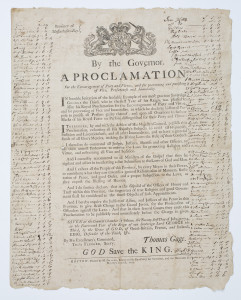Province of Massachusetts-Bay. By the Governor. A Proclamation for the Encouragement of Piety and Virtue… Boston: Margaret Draper, July 23, 1774.
 This important broadside was printed in Boston by Margaret Draper, a loyalist printer who enjoyed the support of Province of Massachusetts Royal Governor Thomas Gage. Gage had been appointed by King George in the spring of 1774 to implement what became known as the Intolerable Acts (or Coercive Acts). Gage was, to put it mildly, very unpopular in Boston. He closed the port and enforced the quartering act, raising the ire of the locals. This proclamation, issued in July of 1774 calls for calm and asks royal subjects to “avoid all Hypocrisy, Sedition, and Licentiousness, and all other Immoralities.” In addition, the proclamation asks for “all People of this Province, by every means in their Power to contribute what they can towards a general Reformation of Manners, Restitution of Peace and good Order.” Gage’s proclamation was met with scorn and his actions to inforce the Acts in Boston helped to fire up the revolutionary spirit in other colonies. By September, the First Continental Congress was holding meetings in Philadelphia to discuss independence. This copy of the proclamation was owned by Elisha May (1739-1811), a justice of the peace and farmer in Attleboro, Massachusetts, who served in the Massachusetts militia from 1775 to 1781. The sheet was reused by the family in 1811 to tally up the holdings in May’s estate, listing more than 130 possessions, from his gun to sheep shears to bundles of hops.
This important broadside was printed in Boston by Margaret Draper, a loyalist printer who enjoyed the support of Province of Massachusetts Royal Governor Thomas Gage. Gage had been appointed by King George in the spring of 1774 to implement what became known as the Intolerable Acts (or Coercive Acts). Gage was, to put it mildly, very unpopular in Boston. He closed the port and enforced the quartering act, raising the ire of the locals. This proclamation, issued in July of 1774 calls for calm and asks royal subjects to “avoid all Hypocrisy, Sedition, and Licentiousness, and all other Immoralities.” In addition, the proclamation asks for “all People of this Province, by every means in their Power to contribute what they can towards a general Reformation of Manners, Restitution of Peace and good Order.” Gage’s proclamation was met with scorn and his actions to inforce the Acts in Boston helped to fire up the revolutionary spirit in other colonies. By September, the First Continental Congress was holding meetings in Philadelphia to discuss independence. This copy of the proclamation was owned by Elisha May (1739-1811), a justice of the peace and farmer in Attleboro, Massachusetts, who served in the Massachusetts militia from 1775 to 1781. The sheet was reused by the family in 1811 to tally up the holdings in May’s estate, listing more than 130 possessions, from his gun to sheep shears to bundles of hops.

Lauren, I love this! Not only does it let you tell the story of the political climate, adding fuel to the fire of the revolutionary spirit, but there’s the local tie to the Attleboro justice of the peace, serving as a record of a family and the times. Not to mention showing how nothing was wasted back then. No separate ledger book for Elisha May, even though, as a militia man and justice of the peace, you would think he could afford it. Thanks for sharing.
Thank you Kathie! We love it for all those reasons. I wonder if May’s family used the proclamation as a scrap to tally his estate as some sort of political statement. Certainly by 1811, anti-British sentiment was building again (pre-War of 1812), so anything printed with the Royal arms might have double meaning!